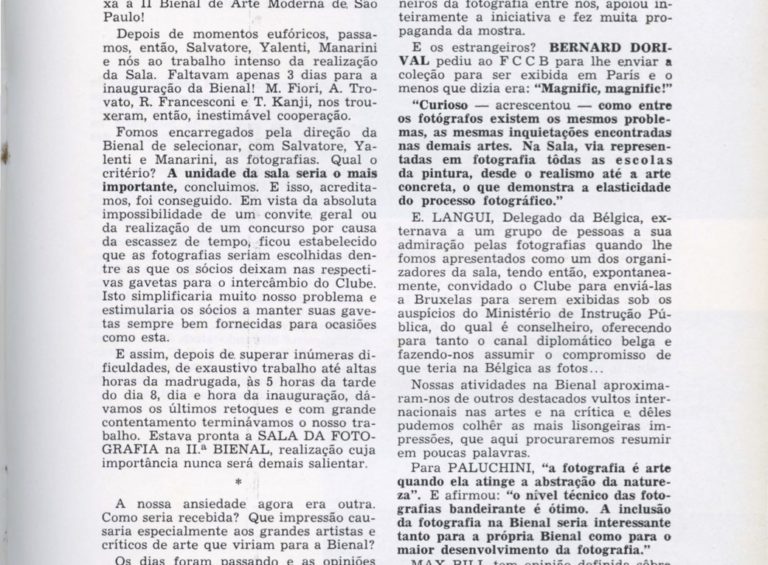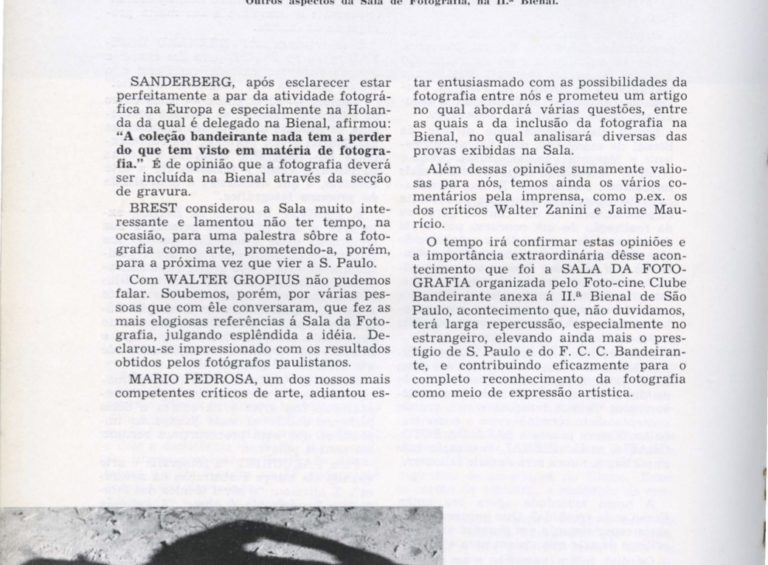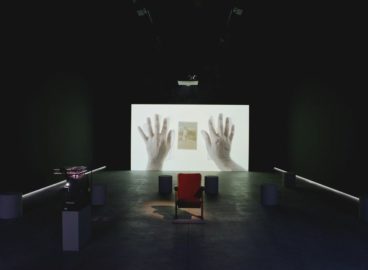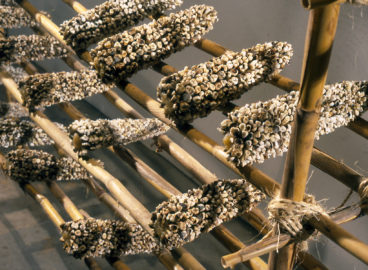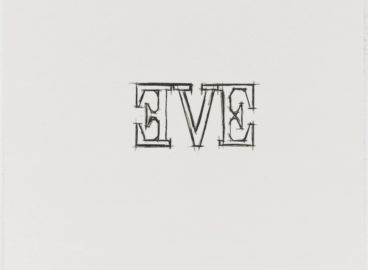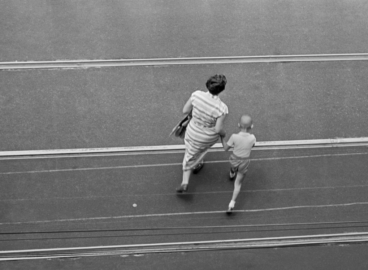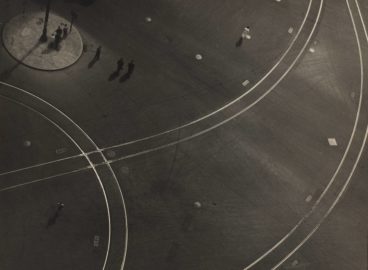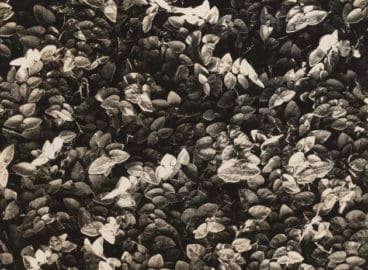Published to coincide with Fotoclubismo: Brazilian Modernist Photography, 1946–1964 at MoMA, Adele Nelson analyzes the Sala de Fotografia, a last-minute, “in-between” and hitherto unexamined exhibition organized by Foto-Cine Clube Bandeirante for the second edition of the São Paulo Bienal. Assembled in the days before the event opened to the public, these were the only photographs displayed at a Bienal planned to coincide with the quadricentennial celebrations of the founding of the city.
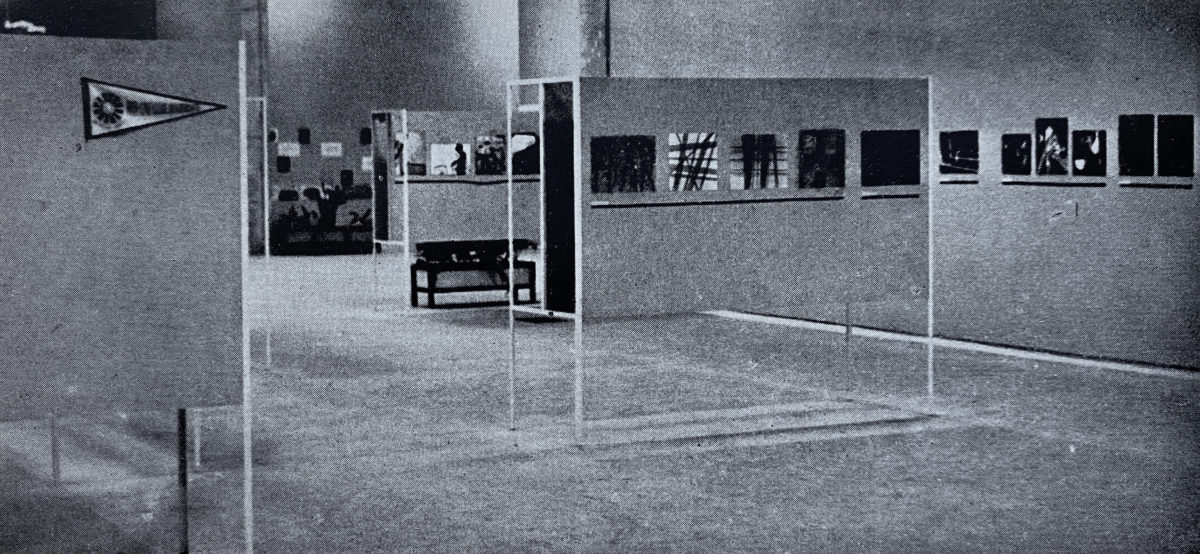
To analyze the photography exhibition at the second São Paulo Bienal (São Paulo Biennial), held in 1953–54, is to necessarily enter the realm of speculation. The Sala de Fotografia (Gallery of Photography) was a last-minute, hastily assembled addition organized by the Foto-Cine Clube Bandeirante (Bandeirante Photo-Cinema Club; FCCB), an amateur photography and film club in São Paulo that held regular salons. There is no trace of the display in the textual and photographic documentation held in the institution’s archive. The club’s bulletin contains a few installation views, but a checklist has not been located (fig. 1). This dearth of records brings into relief the selective, interpretative nature of the historical record of the Bienal as a whole. The organizer of the event, the Museu de Arte Moderna de São Paulo (Museum of Modern Art of São Paulo; MAM-SP), did not photographically document the majority of the exhibition, meaning there are no known visual records in the biennial’s archive of the installations of the representations from Asia, Canada, Eastern Europe, Latin America, and the Middle East, with the exception of a few peopled snapshots at the opening. This practice extended to the Brazilian contributions: there seem to have been no installation views commissioned by the museum of the special exhibitions or of the general section.1The archive of the São Paulo Bienal, the Arquivo Histórico Wanda Svevo at the Fundação Bienal de São Paulo, holds object views of some Brazilian and a few Latin American works displayed. Instead MAM-SP focused its photographic documentation on those exhibitions it deemed the most important, namely those from the United States and Western European nations (fig. 2).
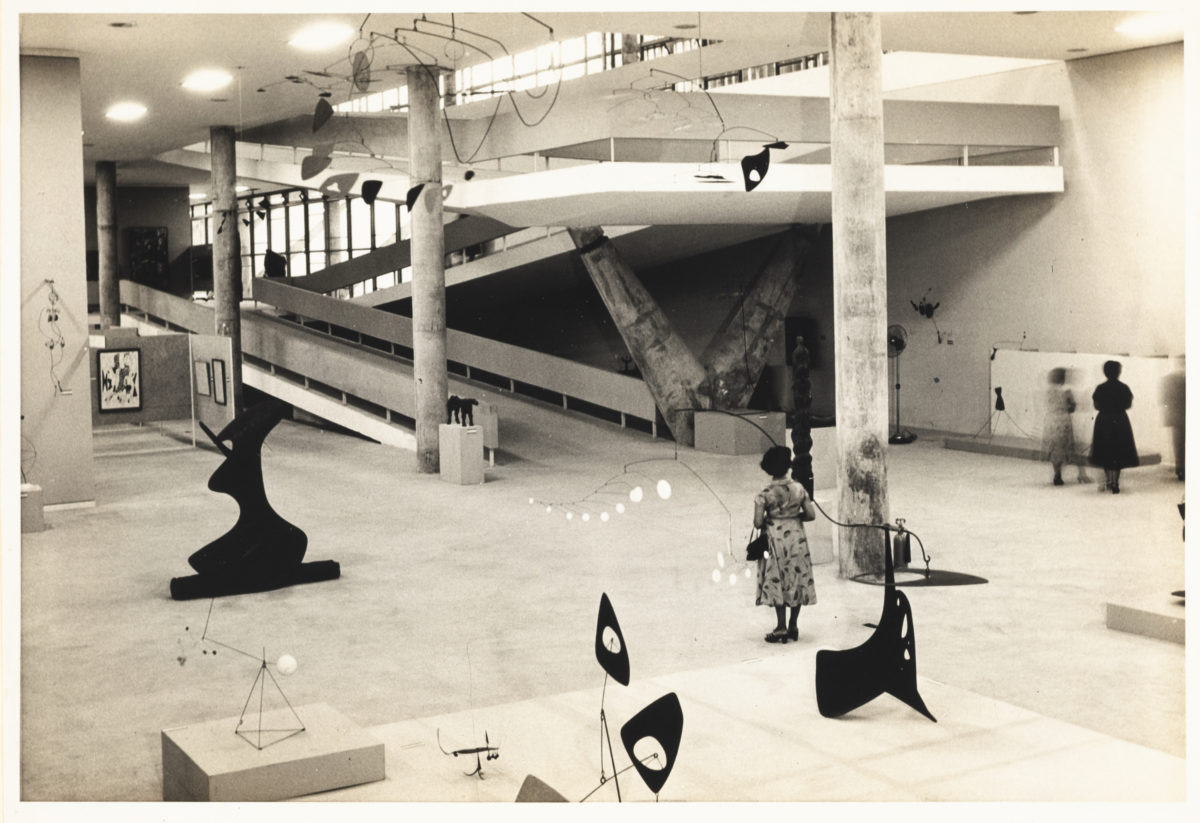
The second Bienal inaugurated the yearlong quadricentennial celebration of the founding of the city of São Paulo, and constituted a veritable temporary museum of modern art, with more than three thousand artworks from thirty-three countries mounted in two newly constructed buildings designed by Oscar Niemeyer. The displays of historical modernism, including Umberto Boccioni’s Unique Forms of Continuity in Space (1913), Pablo Picasso’s Still-Life with Chair Caning (1912) and Guernica (1937), and Piet Mondrian’s Broadway Boogie Woogie (1942–43), were featured in exhibitions dedicated to Cubism, Futurism, and de Stijl, and in tandem with retrospectives of the work of Alexander Calder, James Ensor, Paul Klee, Henry Moore, Edvard Munch, and Picasso. These exhibitions rivaled and often surpassed those at the postwar iterations of the Venice Biennale.
The Sala de Fotografia was organized in the days before the event opened to the public to fill gallery spaces left vacant by cancelled and delayed representations. The regulations of the second Bienal excluded photography from the exhibition; the only place photography was to have appeared in the event was as documentation in the architectural section.2Helouise Costa has noted that the absence of photography at the Bienal contrasts with MAM-SP’s support of modern photography in its early exhibitions. See Helouise Costa, “Da fotografia como arte à arte como fotografia: A experiência do Museu de Arte Contemporânea da USP na década de 1970,” Anais do Museu Paulista: História e Cultura Material 16, no. 2 (July–December 2008): 134–41. FCCB leaders and members took full advantage of the late-breaking decision to include photography in the prestigious event and an opportunity to exhibit the works of its São Paulo–based members outside the club’s annual salons. Three installation views and a dozen object views were published in periodicals, allowing for speculative identification of some of the sixty or so photographs exhibited (fig. 3).3R. T. S., “Fotografias na II Bienal,” Folha da Manhã, January 3, 1954, 4; “Artes plásticas,” Correio da Manhã, February 21, 1954, 11; “Artes plásticas,” ibid., February 27, 1954, 11; “Arte fotográfica na II Bienal,” ibid., February 28, 1954, 11; Boletim Foto-Cine 8, no. 87 (February–March 1954). The table of contents of the latter indicates that all the works illustrated therein were included in the second Bienal. The selection foregrounded geometric abstract and experimental modernist styles, as photography historian Helouise Costa has noted, and the picturesque and realist practices common among club members were excluded.4Helouise Costa, “O Foto Cine Clube Bandeirante no Museu de Arte de São Paulo,”in MASP FCCB: Coleção Museu de Arte de São Paulo Foto Cine Clube Bandeirante (São Paulo: MASP, 2016), 14. Among the known works in the exhibition are Frederico S. Camargo’s Ventoinha (Little Fan), Geraldo de Barros’s Fotoforma no. 12, Thomaz Farkas’s Movimento na praia (Movement on the Beach), Marcel Giró’s Estudo de sombras (Study of Shadows), Tuffy Kanji’s Baixo relêvo (Low Relief), Ademar Manarini’s Composição (Composition), Plínio S. Mendes’s Malabarista (Juggler), Eduardo Salvatore’s Pegadas (Footprints) and Composição (Composition), Rubens Teixeira Scavone’s Abstração 5 (Abstraction 5), and José Yalenti’s Estudo (Study) and Dansa (Dance), as well as untitled works by Francisco Albuquerque, Eduardo Ayrosa, and Manarini.5Prints of Frederico S. Camargo’s and Rubens Teixeira Scavone’s works are included in MoMA’s exhibition Fotoclubismo: Brazilian Modernist Photography, 1946–1964.Based on her analysis of the installation views, Helouise Costa states that Gertrudes Altschul’s Vasos e plantas (Vases and Plants) was in the exhibition. Among the illustrations in Boletim Foto-Cine is a work by Beltran Ascencio, a photographer from the industrial outskirts of São Paulo, who is listed as a member of CCSA. Boletim Foto-Cine 8, no. 87 (February–March 1954): 23; Costa, “O Foto Cine Clube Bandeirante no Museu de Arte de São Paulo,”14n5; Sarah Hermanson Meister, ed., Fotoclubismo: Brazilian Modernist Photography and the Foto-Cine Clube Bandeirante, 1946–1964 (New York: MoMA, 2021), 53, 128. The photography exhibition was the subject of only four known dedicated texts, two of which appear in Boletim Foto-Cine, published by the FCCB.6Wolfgang Pfeiffer, “A fotografia e a II Bienal,” Boletim Foto-Cine 8, no. 87 (February–March 1954): 8–9; Geraldo de Barros, “A sala de fotografia,” ibid., 12–14; R. T. S., “Fotografias na II Bienal”; “Mesa redonda,” O Tempo, unknown date, reprinted in Boletim Foto-Cine 8, no. 87 (February–March 1954): 24–25. The journal’s readership did not reach far beyond the club’s membership, making the Sala de Fotografia a virtually undiscussed entity in the deluge of local and international art criticism surrounding the Bienal.7In “A sala de fotografia,” Geraldo de Barros mentions rave reviews from a host of local critics—Geraldo Ferraz, Maria Eugênia Franco, Sérgio Milliet, Mário Pedrosa, José Geraldo Vieira, and others—as well as visiting foreigners, including Max Bill, Jorge Romero Brest, Walter Gropius, and Bernard Dorival. To the best of my knowledge, these individuals did not comment in print on the photography exhibition, and so these communications were likely personally addressed to Barros or, perhaps, expressed orally in public forums and unrecorded.
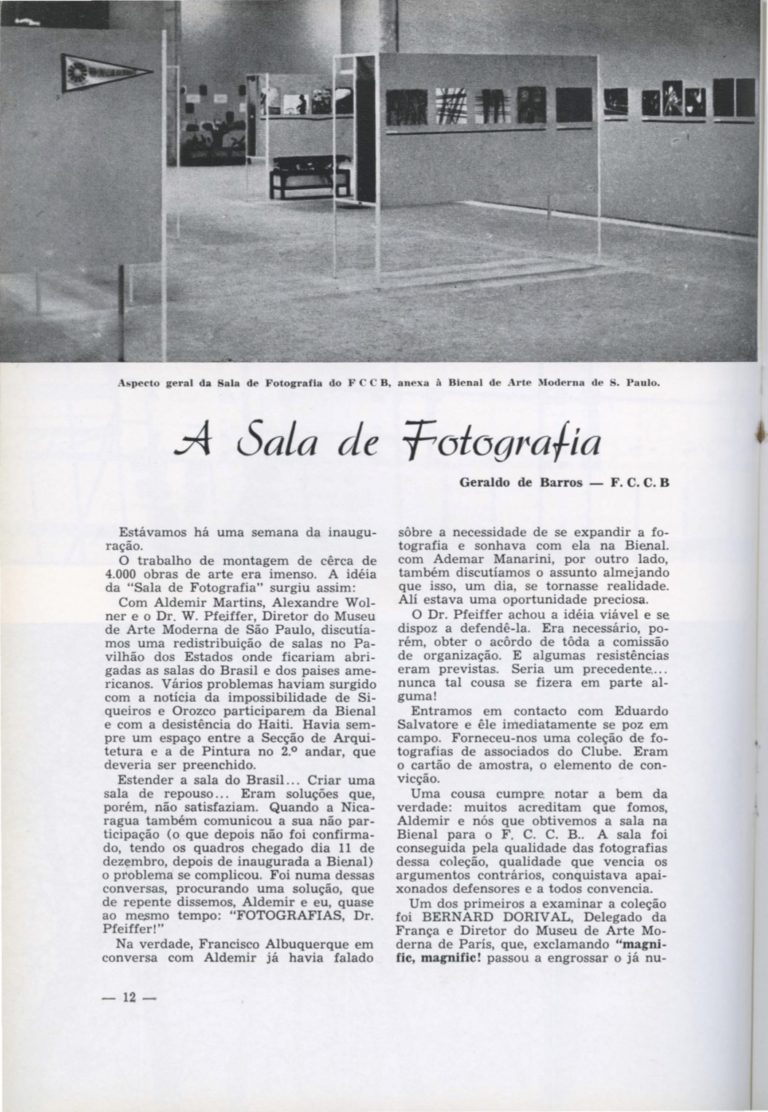

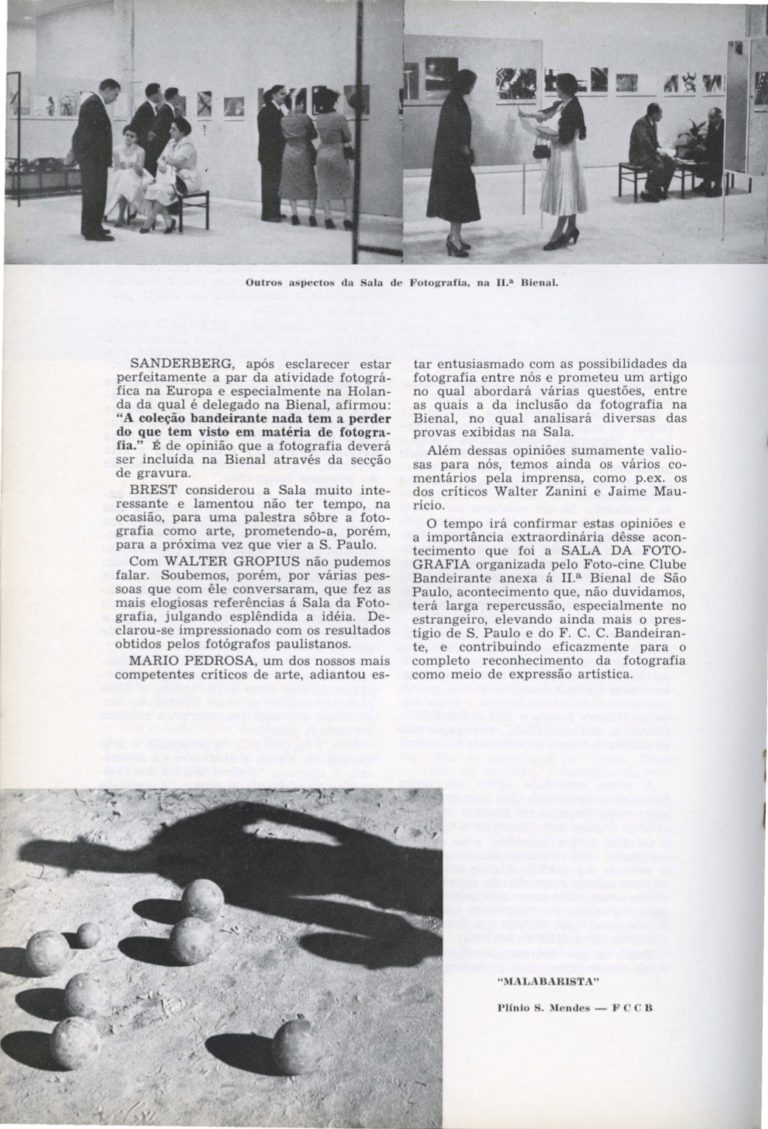
In a firsthand account of the photography exhibition, published soon after the Bienal closed in February 1954, Geraldo de Barros was at pains to address what he viewed as the emerging misconception about his curatorship of the exhibition.8Barros, “A sala de fotografia,” 12. Instead he underscored that the selection and installation were executed by the FCCB with no input from MAM-SP, identifying a large community of artists and art professionals as responsible for conceiving, realizing, and advocating for the project.9Ibid., 12–13. He wrote that he and Aldemir Martins, both employed as hand handlers, proposed the idea to Wolfgang Pfeiffer, the director of MAM-SP, when the Haitian and Nicaraguan representations were cancelled and delayed, respectively.10Ibid., 12. Barros also notes the cancellation of exhibitions dedicated to David Alfaro Siqueiros and José Clemente Orozco. Mexican authorities had long told MAM-SP that these exhibitions were not possible. To stave off criticism, and perhaps because leaders held out hope for a change, the Bienal did not announce Mexico’s decision, and local newspapers continued to list exhibitions dedicated to Siqueiros and Orozco as part of the second Bienal program a few weeks before the event’s inauguration. Leaders and members of the photography club went through the drawers at the FCCB and made a selection from the works on hand with an eye, as Barros explained, toward cohesion.11Ibid., 13. Within FCCB ranks, Barros attributed the original idea of pushing the Bienal to include photography to Albuquerque and Manarini—and described that he, Manarini, Salvatore, and Yalenti selected and installed the works with the help of Mário Fiori, Alfio Trovato, Renato Francesconi, and Kanji. Further, Barros credited Pfeiffer and MAM-SP’s artistic director Sérgio Milliet with persuading the museum’s leadership, and French curator Bernard Dorival and British sculptor Henry Moore, both of whom were on-site installing exhibitions, with winning the crucial support of Francisco “Ciccillo” Matarazzo Sobrinho, MAM-SP’s president.
This type of artistic activism defined the art scene in Rio de Janeiro and São Paulo in the 1950s. The year before, in December 1952, Waldemar Cordeiro, Barros, and five other São Paulo–based abstract artists launched the Grupo Ruptura. In February 1953, artists organized the Exposição Nacional de Arte Abstrata (National Exhibition of Abstract Art) in Petrópolis, near Rio. I argue elsewhere that the stakes of these inaugural group exhibitions of Concrete-oriented abstraction went beyond conceptual positions to extend to the consolidation of collective identities enmeshed with political commitments and institutional critique.12See Adele Nelson, Forming Abstraction: Art and Institutions in Postwar Brazil (Berkeley: University of California Press, forthcoming January 2022). Like those initiatives, the FCCB created spaces—exhibitionary, pedagogical, and social—for its members who collaborated with and criticized Brazil’s modern art institutions. Beginning in the late 1940s and early 1950s, a vocal faction of the FCCB, Barros included, also aligned with vanguard abstraction, successfully advocated for shedding some of the club’s earlier conservatism and affording prominence to modernist experimentation, efforts evident in its intervention at the second Bienal.13Helouise Costa and Renato Rodrigues da Silva, A fotografia moderna no Brasil, 2nd ed. (São Paulo: Cosac Naify, 2004), 33–63; Heloisa Espada, ed., Geraldo de Barros e a fotografia (São Paulo: Instituto Moreira Sales; Edições SESC, 2014), 36–51.
Cordeiro did not participate in the FCCB, but his theorization of the collective life of the artist in texts and talks of the early 1950s framed critical and artistic discourse, and informed the institutional gambits by artist groups. In a 1952 essay titled “The Return of the Artist to Collective Life,” he declared the innovation in Brazil’s abstract painting as comparable to the collaboration between groundbreaking artists during the Italian Renaissance, exceeding aesthetic gains and engendering societal change.14Waldemar Cordeiro, “A volta do artista à vida coletiva,” Folha da Manhã, March 9, 1952, 11. Cordeiro further argued that this renewal relied on robust institutions.15Ibid., 9, 11. He credited the Bienal, the Museu de Arte de São Paulo, the Museu de Arte Moderna do Rio de Janeiro, and MAM-SP for their roles in this flourishing scene, but insisted on the crucial function of artist-run organizations and on the responsibility of the state-run and private art institutions to support artists.16Waldemar Cordeiro, “Salão paulista de arte moderna,” ibid., March 18, 1951, 9. Moreover, Cordeiro and Barros were in active, dynamic dialogue, and had previously deployed the tactic of a coordinated display within a large event, namely the display of the work of Grupo Ruptura and other abstract artists together at the II Salão Paulista de Arte Moderna (2nd Paulista Salon of Modern Art) in 1952. They would later unsuccessfully attempt to persuade MAM-SP to exhibit all of the Grupo Ruptura members at the twenty-seventh Venice Biennale in 1954.
At the second Bienal, the Sala de Fotografia functioned as a threshold between geographies and genres. It was located on the second floor of the Pavilhão dos Estados (Pavilion of States), which displayed the architectural section, or II Exposição Internacional de Arquitetura (2nd International Exhibition of Architecture) composed of documentation of more than two hundred projects, occupying a third of the floor. The remainder of the floor held representations of varying sizes dedicated to nations of the Americas, dominated by painting, and culminating in a special exhibition by Mexican artist Rufino Tamayo. The ground floor and sunken atrium below boasted special exhibitions dedicated to Calder, Brazilian impressionist painter Eliseu Visconti, and Brazilian landscape paintings of the seventeenth through nineteenth centuries, as well as the US and Brazilian representations. Based on textual accounts and the FCCB’s photographic documentation of the installation, it is possible to conclude that the Sala de Fotografia was located in the first of a series of rooms in the middle section of the second floor, near the central ramp, among representations by Caribbean and South and Central American nations (Cuba, Bolivia, Dominican Republic, Nicaragua, Paraguay, and Venezuela). On the floor plan in the event’s catalogue, the Sala de Fotografia is unmentioned, but it was installed in the spaces numbered 22 and 23 (fig. 4). The first wall of the special exhibition dedicated to architect Walter Gropius is captured in the background of one installation view of the photography exhibition (see fig. 1). A visitor would have walked by the entrance to the Sala de Fotografia when entering the architectural section.
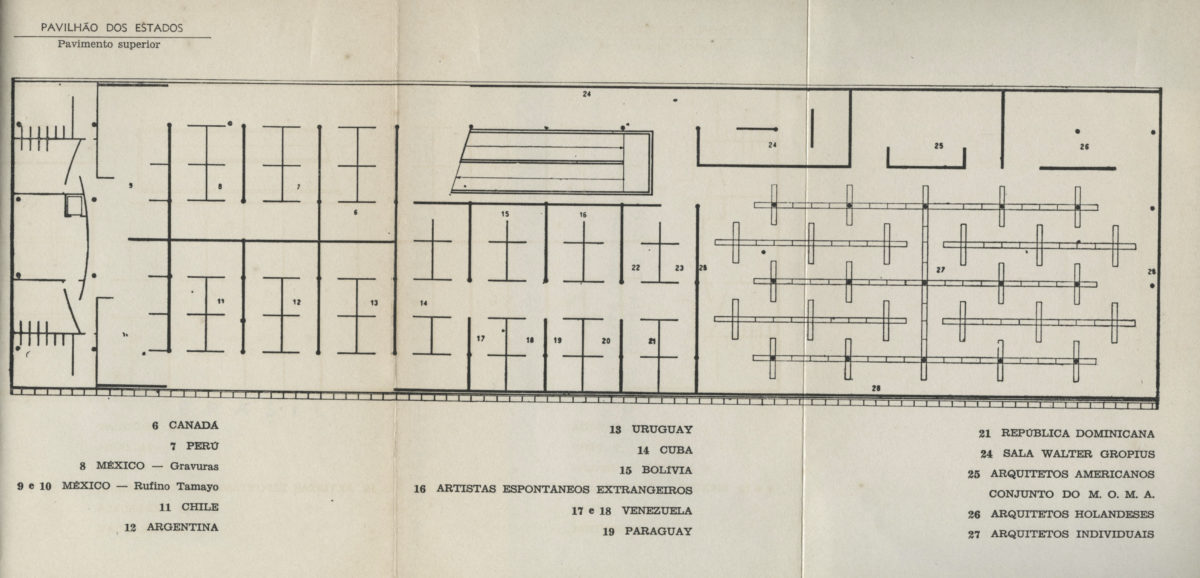
Thus, the Sala de Fotografia was positioned in between documentation of architectural projects and fine art (predominantly paintings), namely displays dedicated to Canada and Latin America and the architectural section dominated by Brazilian, European, Japanese, and US contributions. It is telling that the photography exhibition occupied a space intended to present the only Caribbean nation (Haiti) and was prompted in part by the uncertain arrival of the representation from a Central American nation (Nicaragua). Bienal organizers replicated colonial relations in the lack of priority they granted Latin American nations they deemed minor. José Goméz Sicre, head of the Visual Arts Section of the Pan American Union in Washington, DC, served as an influential informal advisor, organizing the impressive Cuban representation and steering the exhibitions of other Latin American nations. Privately, he criticized MAM-SP for dedicating its financial and staff resources to Euro-American displays while neglecting to secure a wider array of displays from the Americas.17José Gomez Sicre to Arturo Profili, December 2, 1952, box 02/25, folder 2, Documentos históricos: II Bienal de São Paulo, Arquivo Histórico Wanda Svevo, Fundação Bienal de São Paulo. The medium of photography was ultimately included in the Bienal partially thanks to the organization’s lack of cultivation and management of participation from all Latin American nations.
The photography exhibition’s in-between status—Barros described it as an “annex”—was amplified by its design and signage.18Barros, “A sala de fotografia,” 13. The partitions used in the exhibition were the same double-depth ones used in the architectural section—not the single panels deployed elsewhere (fig. 5). This decision conveyed a skepticism, in Brazil and beyond, toward photography’s status as a fine art and instead encoded it, like architecture, as a technically oriented design practice. This was further underscored by the absence of signage standard elsewhere in the Bienal, where plaques printed in uniform, sans-serif modernist typefaces announced the name of a given country or, for special exhibitions, the country name with the addition of a style or artist name, such as “France: Picasso” and “Italy: Futurism.” Instead, a pennant bearing the logo and name of the FCCB appeared outside the gallery (see fig. 1).
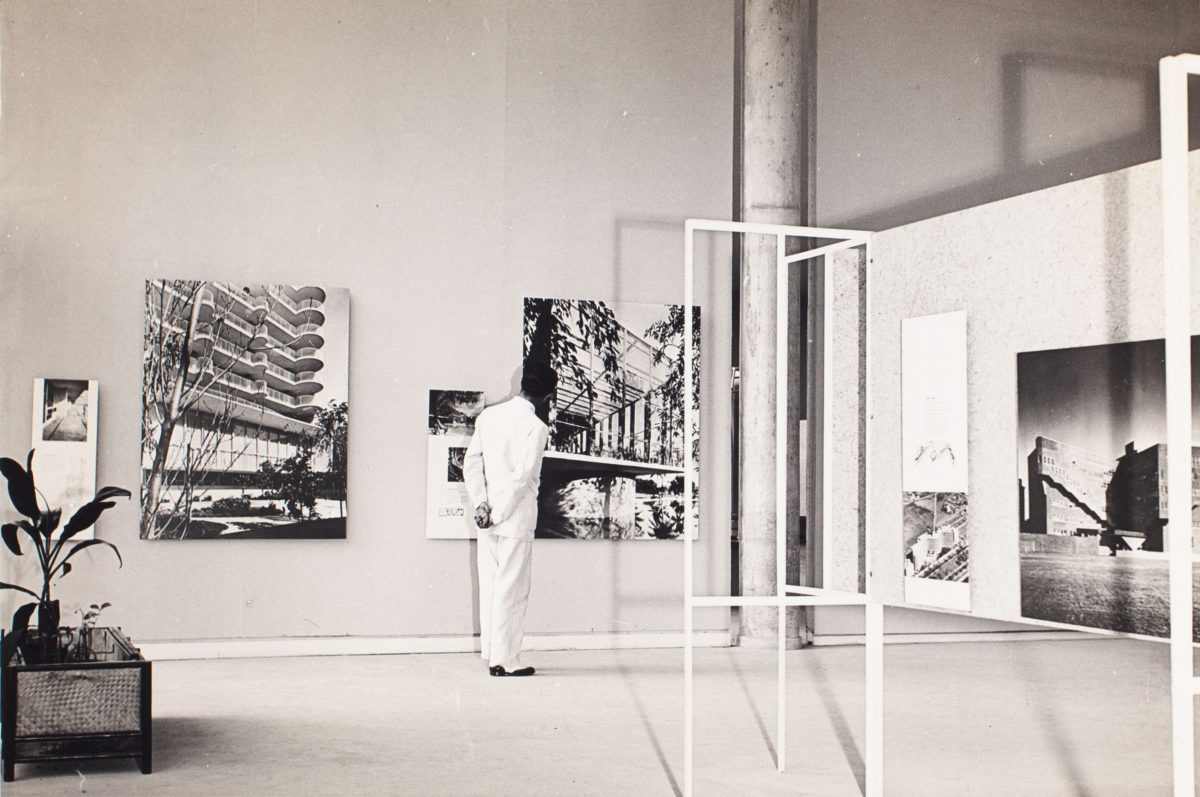
Historian Barbara Weinstein has argued that the larger quadricentennial celebration, which the Bienal inaugurated, consolidated the identity of the city and state of São Paulo as a righteous innovator, racially coded as white, leading a backward nation, racially coded as black, forward.19Barbara Weinstein, The Color of Modernity: São Paulo and the Making of Race and Nation in Brazil (Durham, NC: Duke University Press, 2015). The name Foto-Cine Clube Bandeirante invokes a central figure of that regional identity, the bandeirante, a colonial raider reconceived in mid-century São Paulo as an emblem of the disruptive character of the city and state as a national leader. The FCCB pennant—present as an afterthought in the massive event—makes legible a racialized and neocolonial discourse of progress, and underscores the explicitly Western cultural imaginary mapped in the biennial event as a whole. At the second Bienal, Brazil, with an industrialized, European-descent São Paulo as its standard-bearer, was positioned as a central actor in the Euro-American world and as a privileged nation within Latin America.
- 1The archive of the São Paulo Bienal, the Arquivo Histórico Wanda Svevo at the Fundação Bienal de São Paulo, holds object views of some Brazilian and a few Latin American works displayed.
- 2Helouise Costa has noted that the absence of photography at the Bienal contrasts with MAM-SP’s support of modern photography in its early exhibitions. See Helouise Costa, “Da fotografia como arte à arte como fotografia: A experiência do Museu de Arte Contemporânea da USP na década de 1970,” Anais do Museu Paulista: História e Cultura Material 16, no. 2 (July–December 2008): 134–41.
- 3R. T. S., “Fotografias na II Bienal,” Folha da Manhã, January 3, 1954, 4; “Artes plásticas,” Correio da Manhã, February 21, 1954, 11; “Artes plásticas,” ibid., February 27, 1954, 11; “Arte fotográfica na II Bienal,” ibid., February 28, 1954, 11; Boletim Foto-Cine 8, no. 87 (February–March 1954). The table of contents of the latter indicates that all the works illustrated therein were included in the second Bienal.
- 4Helouise Costa, “O Foto Cine Clube Bandeirante no Museu de Arte de São Paulo,”in MASP FCCB: Coleção Museu de Arte de São Paulo Foto Cine Clube Bandeirante (São Paulo: MASP, 2016), 14.
- 5Prints of Frederico S. Camargo’s and Rubens Teixeira Scavone’s works are included in MoMA’s exhibition Fotoclubismo: Brazilian Modernist Photography, 1946–1964.Based on her analysis of the installation views, Helouise Costa states that Gertrudes Altschul’s Vasos e plantas (Vases and Plants) was in the exhibition. Among the illustrations in Boletim Foto-Cine is a work by Beltran Ascencio, a photographer from the industrial outskirts of São Paulo, who is listed as a member of CCSA. Boletim Foto-Cine 8, no. 87 (February–March 1954): 23; Costa, “O Foto Cine Clube Bandeirante no Museu de Arte de São Paulo,”14n5; Sarah Hermanson Meister, ed., Fotoclubismo: Brazilian Modernist Photography and the Foto-Cine Clube Bandeirante, 1946–1964 (New York: MoMA, 2021), 53, 128.
- 6Wolfgang Pfeiffer, “A fotografia e a II Bienal,” Boletim Foto-Cine 8, no. 87 (February–March 1954): 8–9; Geraldo de Barros, “A sala de fotografia,” ibid., 12–14; R. T. S., “Fotografias na II Bienal”; “Mesa redonda,” O Tempo, unknown date, reprinted in Boletim Foto-Cine 8, no. 87 (February–March 1954): 24–25.
- 7In “A sala de fotografia,” Geraldo de Barros mentions rave reviews from a host of local critics—Geraldo Ferraz, Maria Eugênia Franco, Sérgio Milliet, Mário Pedrosa, José Geraldo Vieira, and others—as well as visiting foreigners, including Max Bill, Jorge Romero Brest, Walter Gropius, and Bernard Dorival. To the best of my knowledge, these individuals did not comment in print on the photography exhibition, and so these communications were likely personally addressed to Barros or, perhaps, expressed orally in public forums and unrecorded.
- 8Barros, “A sala de fotografia,” 12.
- 9Ibid., 12–13.
- 10Ibid., 12. Barros also notes the cancellation of exhibitions dedicated to David Alfaro Siqueiros and José Clemente Orozco. Mexican authorities had long told MAM-SP that these exhibitions were not possible. To stave off criticism, and perhaps because leaders held out hope for a change, the Bienal did not announce Mexico’s decision, and local newspapers continued to list exhibitions dedicated to Siqueiros and Orozco as part of the second Bienal program a few weeks before the event’s inauguration.
- 11Ibid., 13.
- 12See Adele Nelson, Forming Abstraction: Art and Institutions in Postwar Brazil (Berkeley: University of California Press, forthcoming January 2022).
- 13Helouise Costa and Renato Rodrigues da Silva, A fotografia moderna no Brasil, 2nd ed. (São Paulo: Cosac Naify, 2004), 33–63; Heloisa Espada, ed., Geraldo de Barros e a fotografia (São Paulo: Instituto Moreira Sales; Edições SESC, 2014), 36–51.
- 14Waldemar Cordeiro, “A volta do artista à vida coletiva,” Folha da Manhã, March 9, 1952, 11.
- 15Ibid., 9, 11.
- 16Waldemar Cordeiro, “Salão paulista de arte moderna,” ibid., March 18, 1951, 9.
- 17José Gomez Sicre to Arturo Profili, December 2, 1952, box 02/25, folder 2, Documentos históricos: II Bienal de São Paulo, Arquivo Histórico Wanda Svevo, Fundação Bienal de São Paulo.
- 18Barros, “A sala de fotografia,” 13.
- 19Barbara Weinstein, The Color of Modernity: São Paulo and the Making of Race and Nation in Brazil (Durham, NC: Duke University Press, 2015).
